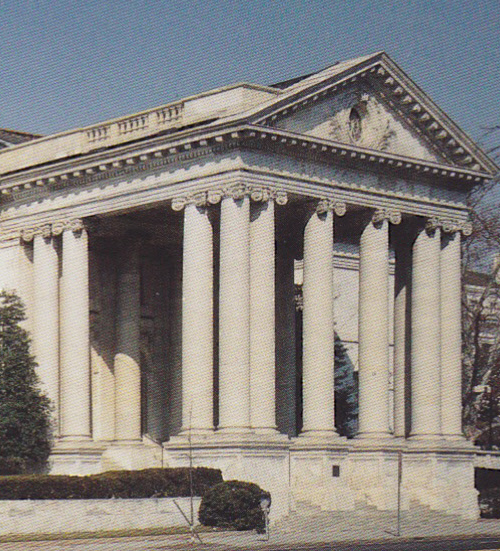On October 5th, Lynn Forney Young, the newly elected President General of the National Society Daughters of the American Revolution (DAR) posted an announcement titled DNA Evidence for DAR Applications and Supplementals on the Today’s DAR website. It explains that “Genealogy staff members at the NSDAR have been studying the potential use of DNA in support of DAR applications and supplemental applications.” While the Office of the Registrar General is “working diligently to finalize the guidelines and develop specific procedures for those wishing to submit DNA evidence,” the main crux of the message is that the national lineage society will accept Y-DNA evidence in support of new member applications, starting January 1, 2014. This is indeed a major policy update for one of the most recognized and respected all-volunteer, non-profit women’s service organizations in the U.S.
For more information on the DAR’s decision to accept Y-DNA testing for their application process, please refer to my blog dated October 13th, titled Now That DAR Accepts DNA Testing – Will Genealogy Be Easier?
Though some self-proclaimed pundits have been critical of the DAR for delaying its acceptance of DNA testing for lineage applications, the DAR has been taking a methodical and scientific approach to DNA testing for lineage proof. While the Society accepts genetic genealogy as a beneficial aid to solving some hard-to-answer lineage questions, it also recognizes the inability of chromosomal testing to definitively identify a specific ancestor in all cases. Therefore, the DAR will not accept Y-DNA evidence as “stand-alone proof of lineage because while it can be used as a tool point to a family, it cannot be used as absolute proof for an individual.”
To better understand this, consider the case of Thomas Jefferson and Sally Hemings. In 1998, the journal Nature reported that Jefferson had a slave mistress with whom he fathered six children, basing the claim on a pairing of historical records with DNA evidence tracing Y-chromosomes. The genetic testing was conducted by Dr. Eugene Foster and a team of geneticists. Since Jefferson had no adult sons by his marriage to wife Martha, the team tested Y-chromosomal DNA samples from male-line descendants of Field Jefferson (Thomas Jefferson’s uncle); John Carr (grandfather of Jefferson’s Carr nephews); and Eston Hemings (born 1808), who was the last known child born to Sally Hemings. The results indicated a genetic link between the Jefferson and Hemings descendants.
In response to the report, the Monticello Association – a lineage group of several hundred descendants of Thomas and Martha, along with other critics – raised the argument that Y-DNA testing results showed only that a Jefferson – not specifically Thomas Jefferson – fathered the Hemings offspring, noting that there were as many as 25 Jefferson men living in Virginia during that era. Additionally, Thomas had invited his younger brother Randolph to Monticello just before Eston was conceived; however, it is not known whether Randolph actually went or not.
According to Monticello.org, soon after the Foster report was released in 1998, the Thomas Jefferson Foundation (TJF) formed its own TJF Research Committee; and in January 2000, it released the Thomas Jefferson Foundation (TJF) Research Committee Report on Thomas Jefferson and Sally Hemings. The research indicated that “the weight of all known evidence – from the DNA study, original documents, written and oral historical accounts, and statistical data – indicated a high probability that Thomas Jefferson was the father of Eston Hemings, and that he was likely the father of all six of Sally Hemings’ children listed in Monticello records – Harriet (born 1795; died in infancy); son Beverly (born 1798); an unnamed daughter (born 1799; died in infancy); Harriet (born 1801); son Madison (born 1805); and son Eston (born 1808).”
The battle still continued. While President Bush played host to the descendants of Hemings and Jefferson at the White House in 2001, in celebration of Thomas Jefferson’s 258th birthday, the Thomas Jefferson Heritage Society announced the findings of its own paternity study. Worried that the integrity of Thomas Jefferson’s name was being undermined, the Heritage Society stated that, “The allegation is by no means proven.” The TJ Heritage Society saw Sally Hemings as “only a minor figure in Thomas Jefferson’s life.” The committee report (issued April 2001, revised 2011) suggested that Jefferson’s younger brother Randolph (1755-1815) “was more likely the father of at least some of Sally Hemings’ children.”
More than a decade after its own comprehensive report in 2000, TJF and most historians still believe that widower Thomas Jefferson fathered six children with Sally Hemings. While two babies died in infancy, four of the children – Beverly, Harriet, Madison, and Eston Hemings – survived and are mentioned in Jefferson’s records. Thomas Jefferson freed Beverly and Harriet, who left Monticello in 1822, while Madison and Eston achieved their freedom as stipulated in Jefferson’s 1826 will.
Because of their light-skin, three of Sally Heming’s children (daughter Harriet and sons Beverly and Eston) lived as members of white society, while Madison chose to remain in the black community. According to Madison, his mother Sally, who was also light-skinned, was the granddaughter of an African woman and English sea captain John Wayles, who happened to be Thomas Jefferson’s father-in-law. Both sides of the family have honored the descendants of Thomas Jefferson’s and Sally Hemings’ union throughout the generations.
One Jefferson-Hemings descendant, who happens to be a DAR member, was present at the White House fête in 2001. She explained to U.S. News & World Report that her 19th-century Hemings’ kin changed their name to Jefferson and lived as whites. But despite all the scientific advancements in genetic testing, it’s important for readers to understand that even though this DAR member’s Y-chromosome testing results show definitively that she is a Jefferson descendant, it can not show definitively which Jefferson male was her great-great-great grandfather. Only in conjunction with other historical documentation can the assumption be made that she is indeed related to Thomas Jefferson.
While we look to science and technology to make our daily lives easier, sometimes they can open a can of worms. The same is true for DNA testing. While not the be-all and end-all we would like it to be, genetic testing can and will indicate biological markers that no document nor word of mouth can prove. It is yet another tool in the holistic approach to ancestry research. RecordClick takes the holistic approach to trace family trees, by adding DNA testing kits as part of its comprehensive toolbox of genealogy research services. If you are interested in DNA testing to enhance your genealogy research, contact RecordClick today.
Any woman is eligible for membership in the National Society Daughters of the American Revolution (NSDAR) if she is 18 years of age or older and can prove lineal, blood line descent from an ancestor who aided in achieving American independence. She must provide documentation for each statement of birth, marriage, and death. Admission to membership in the NSDAR is by invitation through a Chapter in your State Organization (or Unit Overseas). No Chapter may discriminate against an applicant on the basis of race or creed.
Sources:
Foster, Eugene A., M. A. Jobling, P. G. Taylor, P. Donnelly, P. de Knijff, Rene Mieremet, T. Zerjal and C. Tyler-Smith. Nature – International Weekly Journal of Science (http://www.nature.com/nature/journal/v396/n6706/abs/396027a0.html : accessed 12 October 2013), “Jefferson Fathered Slave’s Last Child”
Lord, Lewis. U.S. News & World Report (http://www.usnews.com/usnews/news/articles/010423/archive_001670.htm : posted 15 April 2001, accessed 12 October 2013), “Jefferson, Hemings – Again : A New Report, and More Questions about an Alleged Affair”
Monticello (http://www.monticello.org/site/plantation-and-slavery/thomas-jefferson-and-sally-hemings-brief-account?page=1 : accessed 12 October 2013), “Thomas Jefferson and Sally Hemings: A Brief Account”
Photo courtesy of the National Society Daughters of the American Revolution







